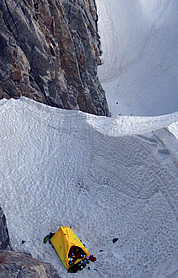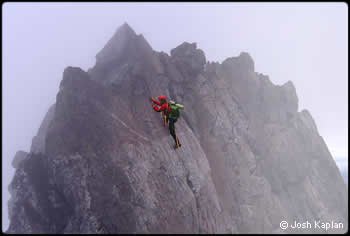 |
 e
started the long alpine section of the traverse on our third day.
We felt like two nervous intruders making their way up
the East Peak of Fury in thick fog.
The “commitment zone” lay ahead.
From here, climbing would be difficult and treacherous
and bail-out opportunities scarce.
West Fury was uneventful, except when we
began descending the wrong ridge into the west drainage.
Thankfully the clouds lifted just enough for us to see this
terrible mistake in the making.
We returned to the top and launched into a series of
rappels that beggared our imagination.
The final rap went down a huge vertical cliff that
required the full length of both ropes.
We were glad that we never had to face climbing that cliff
during our previous attempt.
Afterward, we climbed several difficult leads
along the ridge before rapping onto a glacier in a col
beyond West Fury, where we made a camp on snow in a wind hollow.
A rock patio provided some insulation from a freezing night;
we dubbed this camp “Ice Station
Zebra.” e
started the long alpine section of the traverse on our third day.
We felt like two nervous intruders making their way up
the East Peak of Fury in thick fog.
The “commitment zone” lay ahead.
From here, climbing would be difficult and treacherous
and bail-out opportunities scarce.
West Fury was uneventful, except when we
began descending the wrong ridge into the west drainage.
Thankfully the clouds lifted just enough for us to see this
terrible mistake in the making.
We returned to the top and launched into a series of
rappels that beggared our imagination.
The final rap went down a huge vertical cliff that
required the full length of both ropes.
We were glad that we never had to face climbing that cliff
during our previous attempt.
Afterward, we climbed several difficult leads
along the ridge before rapping onto a glacier in a col
beyond West Fury, where we made a camp on snow in a wind hollow.
A rock patio provided some insulation from a freezing night;
we dubbed this camp “Ice Station
Zebra.”
 |
 |
|
Camp Ice Station Zebra. Photo © Josh Kaplan |
|
 |
We rejoiced at clear skies the next morning.
We thought we might actually catch a break,
until we saw the first high clouds. “DAMN!
We have 12-24 hours,” I screamed to Josh.
We didn’t enjoy hurrying over loose and dangerous rock,
but we relished even less the idea of being caught up here in rain.
Racing over the remaining small peaks and maze of ridges,
we reached the Spectre plateau and found an easy route up Swiss Peak.
Phantom Peak provided some off-route fun,
as we climbed over and back via the “Cub Scout Salute,”
a spire that resembles a two-finger salute from the west.
The spires of the ridge continued; steep snow traverses brought
us to the summit rocks of these remote formations.
Approaching our end-point from the previous year,
we realized that we would have to bivouac again.
We found a beautiful spot in the Phantom-Ghost col,
our previous end-point, and camped early, determined
not to tire ourselves too much before the last day’s push.
I rationalized our shortened day by thinking,
“All we need is six good hours to finish the climb.”
We got four.
The weather deteriorated on our fifth day.
I noticed moisture starting to condense on the rope as
we simul-climbed over Ghost Peak. The knife-edge arête
of Mount Challenger became desperately slippery as the rain began.
The wind gusted up and the rain switched briefly to ice pellets.
Our mood turned grim. We knew we were in a risky environment.
Josh climbed with his gloves on to combat the cold.
We no longer trusted our wet boots on the slick footholds and
we relied almost entirely on handholds to grip the rock.
We reached the end of the traverse not with a sense of
triumph, but with numbed relief.
I couldn’t talk or think clearly and I saw the same
look in my partner’s face; we had survived.
We had pushed ourselves into a zone of commitment and risk
that some might criticize, but we had also lived
our dream of a most amazing mountain odyssey.
We had no time for celebration on this summit, exposed as we were to
the elements. A thirty-hour storm was upon us. Two days would pass before
we would feel dry and warm again. Tough-guy Josh had left his rain gear
at home, relying only on a down jacket. Facing a wet bivy, we wanted to
get as far down Wiley Ridge as possible. We marched along the tortuous
ridge as the evening hours slipped away. Not comfortable descending the
last three thousand feet to Beaver Pass in darkness and cloud, we stopped
in the gloom.
A miserable and long night slowly passed;
I dreamt of flooding, swimming, and rescue.
The sickly light of sunrise barely penetrated
the storm clouds to reach our chilled and aching bodies.
We finally began to warm up during the steep plunge
downhill into the brush and forest.
At the valley bottom, the Big Beaver trail felt like a
lifeline drawing us toward home.
Warmer air allowed us to relax, and we could finally begin
to celebrate our success.
What joy we felt after so many days of intense concentration!
Hoping to get home a day early,
I took much of the weight and let Josh
run ahead to try and catch the boat.
Luck was with us when we recovered our cache and snagged an
early pick-up after six life-changing days.
We had gone over sixty miles, ten of them,
from Luna Peak to the glacier by Eiley Lake, fully alpine.
We had traversed over the summits of nine remote peaks of
the amazing Northern Picket Range.
|
 |
| The
First Pickets Traverse |
In
ten days in 1963, Alex Bertulis and Half Zantop made the first traverse
of the Picket Range, establishing a style that in many ways is the
spiritual grandfather of the contemporary traverses, although few
modern climbers know of their accomplishment.
Days 1-3
Hike Goodell Creek to East McMillan Spire in rainy weather.
Day 4
Contour Upper Terror Basin.
Abandon attempt on Degenhardt (weather) and descend into Crescent
Basin.
Day 5
Climb West Ridge of Terror.
Rappel (dulfersitz) the unknown and vertical North Face (2,000 feet)
using all their anchor material and cutting up some of their rope.
Benighted.
Day 6
Complete descent to headwaters of McMillan Creek.
Day 7
Climb over Peak 7,680, down its west side and up Fury’s south
glacier to camp on Fury’s east ridge.
Day 8
Complete the climb of Mount Fury and descend its north flank. Bathe
in meltwater near Luna Peak.
Day 9
Climb south side of Challenger. Encounter another party on Challenger,
descend Challenger Glacier to Perfect Pass then to Easy Ridge.
Day 10
Hike out via Hannegan Pass and trail.
|
| |
|
 |
|



